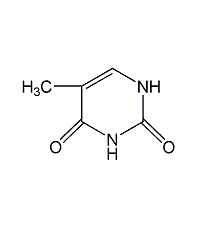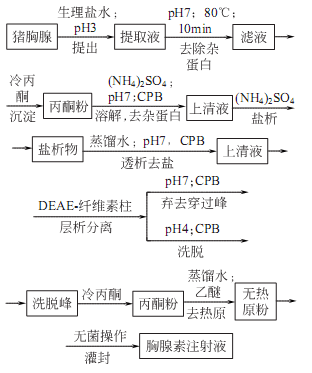
Structural formula
| Business number | 01DX |
|---|---|
| Molecular formula | C5H6N2O2 |
| Molecular weight | 126.11 |
| label |
2,4-dihydroxy-5-methylpyrimidine, Thymosin F5, Thymosin, Thymosin-F5, 2,4-Dihydroxy-5-methylpyrimidine, 5-Methyluracil, Surfactant |
Numbering system
CAS number:65-71-4
MDL number:MFCD00006026
EINECS number:200-616-1
RTECS number:XP2100000
BRN number:117880
PubChem number:24899883
Physical property data
1. Appearance: White crystalline powder
2. Density (g/mL, 25/4℃): Uncertain
3. Relative vapor density (g/mL, Air = 1): Uncertain
4. Melting point (ºC): 335-337 (decomposition) 5. Boiling point (ºC, normal pressure): Uncertain
6. Boiling point (ºC, 5.2kPa): Unknown Confirm
7. Refractive index: Uncertain
8. Flash point (ºC): Uncertain
9. Specific rotation (º): Uncertain
10. Autoignition point or ignition temperature (ºC): Uncertain
11. Vapor pressure (kPa, 25ºC): Uncertain
12. Saturation Vapor pressure (kPa, 60ºC): Uncertain
13. Heat of combustion (KJ/mol): Uncertain
14. Critical temperature (ºC): Uncertain
15. Critical pressure (KPa): Uncertain
16. Log value of oil-water (octanol/water) partition coefficient: Uncertain
17. Explosion upper limit (% , V/V): Uncertain
18. Lower explosion limit (%, V/V): Uncertain
19. Solubility: Hardly soluble in water at room temperature, slightly soluble in Alcohol, soluble in alkali, acid, formamide, DMF and pyridine
Toxicological data
Acute toxicity: Mouse oral LC50: 3500 mg/kg; Mouse intraperitoneal LCLo: 1 mg/kg;
Mutagenicity: Bacteria-Escherichia coli phage inhibition capacitance test system: 1 gm/L
Ecological data
None yet
Molecular structure data
1. Molar refractive index: 29.71
2. Molar volume (cm3/mol): 102.7
3. Isotonic specific volume (90.2K ): 251.3
4. Surface tension (dyne/cm): 35.7
5. Polarizability (10-24cm3): 11.77
Compute chemical data
1. Reference value for hydrophobic parameter calculation (XlogP): None
2. Number of hydrogen bond donors: 2
3. Number of hydrogen bond acceptors: 2
4. Number of rotatable chemical bonds: 0
5. Number of tautomers: 9
6. Topological molecule polar surface area 58.2
7. Number of heavy atoms: 9
8. Surface charge: 0
9. Complexity: 195
10. Number of isotope atoms: 0
11. Determine the number of atomic stereocenters: 0
12. Uncertain number of atomic stereocenters: 0
13. Determine the number of chemical bond stereocenters: 0
14. Number of uncertain chemical bond stereocenters: 0
15. Number of covalent bond units: 1
Properties and stability
None yet
Storage method
Aseptic sealed packaging in brown glass bottles. Store at low temperature and dry place.
Synthesis method
1.

. After fresh or frozen thymus is defatted and minced, add 3 times the amount of normal saline, make a homogenate in a tissue masher, and centrifuge at high speed to obtain the extract (component 1). The extraction solution was heated at 80°C for 15 minutes to precipitate heat-labile impurity proteins. Centrifuge to remove the precipitate and obtain the supernatant (component 2). The supernatant was cooled to 4°C, then 5 times the volume of -10°C acetone was added, the precipitate was collected by filtration, and dried to obtain acetone powder (component 3). Dissolve acetone powder in phosphate buffer solution with pH=70, add ammonium sulfate until the saturation is 025, centrifuge to remove the precipitate, adjust the supernatant (component 4) to pH=40, and add ammonium sulfate When the saturation is 050, a salt precipitate is obtained. Dissolve the salted out product in a phosphate buffer solution with pH=8, filter it, and then take the ultrafiltrate with a relative molecular mass of less than 15,000. The ultrafiltrate is desalted through a Sephadex G25 column and freeze-dried to obtain thymosin.
Purpose
1. Mainly used as an immune enhancer. It can be used to treat immune deficiency diseases such as thymic agenesis syndrome and ataxia telangiectasia. Domestically used to treat recurrent aphthous ulcers, severe leprosy infections and other diseases associated with low immune function.
2.The main function of thymosin is to enhance immunity, promote the differentiation of primitive stem cells or immature T lymphocytes in the thymus into mature cells, and promote cell growth. Immunity T lymphocytes. In addition, it has an antagonistic effect on corticotropichormones and gonadotropins. The amount of thymosin contained in the human body is inversely proportional to age. The use of thymosin in beauty products can promote skin regeneration and delay skin aging.

 微信扫一扫打赏
微信扫一扫打赏

